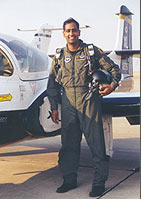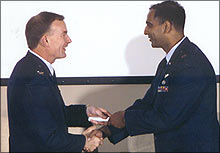The Rediff US Special/Aziz Haniffa, India Abroad


He may not be as famous as his elder brother -- the politician Satveer Chaudhary, who is a senator in Minnesota -- but Captain Ravi Inder Chaudhary, 31, is no less an achiever.
He is among the few Asian Americans to stray from the traditional fields of computers, medicine and law, choosing instead to become a fighter pilot for the United States Air Force.
And, very soon, Capt Chaudhary may become one of the USAF's most versatile pilots, able to handle cutting-edge combat aircraft as well as the huge transports like the C-17s, which are designed to land on unapproved airstrips.
Chaudhary received his pilot's Wings recently after completing 52 weeks of training at the Laughlin Air Force Base, 47th Flying Training Wing, in Del Rio, Texas. He has already flown many humanitarian missions, including airlifting earthquake relief to India.
"After 52 weeks of training, it was quite a feeling to be able to pin the wings of an air force pilot on my uniform," he says.
"I am excited at the opportunity to fly such sophisticated aircraft," particularly the C-17, which "despite the obvious hi-tech automation, is a pleasure to fly and very manoeuvrable for an aircraft of its size," he adds.
"It's an indescribable high!" he says, describing his feeling when his instructor allowed him to fly loops in a fighter aircraft.

|
|
Col Jack Eggington, commander of the 47th Flying Training Wing, awarding Capt Ravi Inder Chaudhary his wings on April 27
| |
"Formation flying was the most baffling of all my phases of training. I was expected to fly in fingertip formation only a few feet from the flight lead through a series of acrobatic turns and twists. I have never been required to complete a task with such precision! It's like an aerial ballet.
"You're all over the place on the first few flights, but then, like everything else in this programme, things just fall into place and it's beautiful once you figure it out."
But Chaudhary, who always dreamed of being a pilot and whose son Krishan, now six months old, was born during his training, says he never would have made it "without the undying support of my wife Uma", a speech language pathologist. "Family is never distant from your mind as you ascend through the programme.
"In the end, after all the check ride exams, simulators, academics and tests are completed, you come home exhausted to your wife and child and realize that they are the reason you are working so hard."
"Overall," Chaudhary declared, "what it's all about is service to your country, patriotism, teamwork, family and the love of flying."
The Minneapolis-born Chaudhary attended Columbia Heights High School in Minnesota, graduating in 1988. He then entered the University of Minnesota on a four-year AFROTC (Air Force Reserve Officer Training Corps) scholarship. After a year, he earned an appointment to the USAF Academy, from where he received a bachelor's degree in aeronautical engineering and a commission in the air force in June 1993.
After graduating from the academy, Chaudhary reported to the Space and Missile Systems Centre, Los Angeles air force base, where he supported three successful Delta II launch missions that resulted in the Navstar global positioning system reaching full operational capability and setting a world record for consecutive successful launches by an unmanned space vehicle.
In March 1996, Chaudhary reported to Kelly air force base in Texas, where he was responsible for designing critical inspection procedures for the C-5 and T-38 aircraft and also led experimental programmes to insert state-of-the-art aircraft radiography technologies. He also developed a non-destructive test solution to T-38 wing inspections in direct support of flight operations and his efforts helped his team get selected as the 1997 materiel command engineering team of the year.
The next year, he was selected as a flight test engineer for the 313th Flight Test Squadron, also in Kelly AFB, where he designed and executed flight tests for C-5, T-38 and T-37 aircraft. During this period, Chaudhary logged numerous test sorties, leading multiple avionics upgrades and qualifying new engine components. Once again his efforts helped the 313th FLTS win the award for the 1997 materiel command test team of the year.

|
|
Capt Ravi Chaudhary with his wife Uma
| |
Then, during an assignment with the 339th FLTS in Robins AFB, Georgia, where he was leading the transition during a $1 billion upgrade of C-5, C-130, C-141 and F-15 aircraft, Chaudhary was selected for a NASA graduate research fellowship to integrate air force structural repair techniques on the International Space Station.
As a fellow at the National Aeronautics and Space Administration, Chaudhary supported the efforts to develop the first-ever on-orbit space debris repair kit, qualified as an engineering support diver in Johnson Space Centre's underwater neutral buoyancy laboratory, and aided astronauts in the development of critical extra-vehicular activity (space-walk) procedures.
After that, he reported to Laughlin AFB for specialized pilot training. On graduation he has been assigned to the 97th Air Mobility Wing for initial flying of the Boeing C-17 Globemaster III.
Chaudhary has written more than 20 technical documents and has been published in five different engineering journals and magazines. His military decorations include the Aerial Achievement Medal, Air Force Commendation Medal, and Military Outstanding Volunteer Service Medal.
Back to top
Tell us what you think of this feature